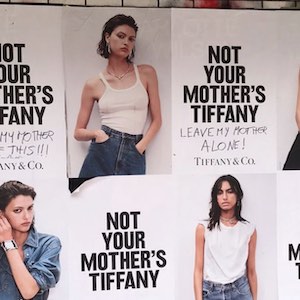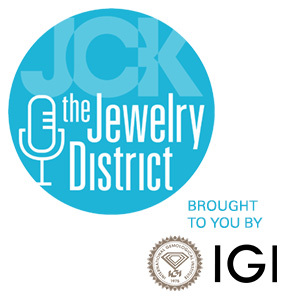
Tiffany & Co. is nearly 185 years old. And like many vintage brands, it’s caught between the past and present.
On the one hand, it has an incredible heritage and history. On the other, a lot of young shoppers don’t care about that stuff.
This tension between the customers Tiffany has and the customers it knows it needs has dogged the company since at least the 1990s, according to someone who worked there back then.
“There was a big difference between the ‘big jewelry’ purchasers (even then, it was an older clientele) and the more ‘trendy modern self-purchase’ audience that they were trying to cultivate even in the ’90s with their sterling jewelry (Atlas, Paloma [Picasso], Elsa [Peretti], etc.),” this person said.
Of course, it’s quite possible that some of those 1990s “trendy modern self-purchasers” eventually turned into “big jewelry” customers. By hooking them early, Tiffany created brand loyalists.
For years, Tiffany has tried to make itself relevant to today’s “trendy modern” shoppers. Its latest effort—the “Not Your Mother’s Tiffany” campaign—is perhaps its most explicit yet. But it’s also caused a bit of a stir. (The company did not respond to a request for comment.)
Some things about this campaign are commendable. The House of the Blue Box deserves credit for trying something different. Now that LVMH has removed the company from the public markets, it can take more chances.
In addition, people are talking about this. In the “attention economy,” that’s a win.
Then again, not all of that attention is positive.
People are really going on two thousand word rants on LinkedIn about how much they hate the Tiffany & Co "not your mother's Tiffany" campaign.
I've never seen anything like it.
— Michael J. Miraflor (@michaelmiraflor) July 26, 2021
Why are people so put off? For starters, fresh thinking should be just that, fresh. The slogan is a clear retread of “This is not your father’s Oldsmobile,” a tagline the car brand used in the late 1980s. And while that phrase was catchy and memorable, the campaign overall was a notorious flop, and one of the reasons you don’t see Oldsmobiles on the road anymore.
“How bad was the campaign?” wrote blogger Ary Rosenbaum. “In 1986 (two years before the ads), [Oldsmobile] sold 1,050,832 vehicles. By 1990, sales were down to 489,492.”
The second reason is that Tiffany is telling, not showing. If it has new product that can appeal to younger consumers, it should tout it. You get young consumers in the door by having product they want to buy.
“I’d be far more interested in a bold stand outlining what the Tiffany & Co. brand stands for,” wrote one commenter on LinkedIn, “rather than just standing ‘against’ a more dated version of themselves.”
To put it another way, if the company really wasn’t your mother’s Tiffany, it wouldn’t need to say so. Or, as a LinkedIn commenter said more bluntly, “Giving voice to your primary anxiety via advertising doesn’t strike me as a winning strategy.”
Finally, the campaign feels exclusionary. It’s implicitly telling certain shoppers: We don’t want you.
As Rosenbaum wrote about the Oldsmobile campaign: “There is nothing wrong with trying to reinvent your brand, but you can do [so] without insulting your long-time customers. Oldsmobile couldn’t attract new buyers to its reinvented brand and only destroyed its customer base.”
Yes, Tiffany needs shoppers like Alexandre Arnault, the 29-year-old who is now running its communications. But the company’s backbone is people like his 72-year-old father, LVMH chair Bernard.
When the elder Arnault purchased Tiffany, he promised to make it a “little bit French.” It wasn’t clear what he meant by that, but most thought he wanted to remake Tiffany as a traditional luxury brand: more exclusive, stuffy, possibly even arrogant.
But that is not the Tiffany DNA. I had always imagined it as an intimidating place. But when I visited the Fifth Avenue flagship, I found it inviting. It looked like a department store. Its most famous (fictional) customer, Holly Golightly, didn’t buy there. She browsed.
“[Tiffany] was…and it still is—I don’t know if it will remain that way—the most democratic store that I’ve ever been to that sells beautiful things,” one shareholder told WWD. “Democratic with a small ‘d.’ ”
The “not my mother” ads might not be staid or stuffy, but they do come off as arrogant. It’s the arrogance of youth, of “cool,” of rich kids spending lots of money to try to look sloppy. The models appear dour and aloof. The ads don’t sparkle. They aren’t warm. They’re not enticing. They aren’t fun.
And Tiffany needs to be all those things. Because even with its new hipster-ish trapping, it still might not seem welcoming to the kind of T-shirt-wearing teens featured in those ads. They are not its standard clientele.
Which doesn’t mean they’ll never go. They just might like it better if they went with their moms.
(Top photo courtesy of @dimepiece.co)
- Subscribe to the JCK News Daily
- Subscribe to the JCK Special Report
- Follow JCK on Instagram: @jckmagazine
- Follow JCK on X: @jckmagazine
- Follow JCK on Facebook: @jckmagazine





